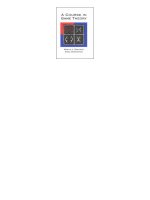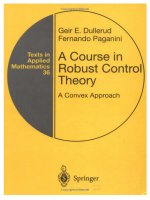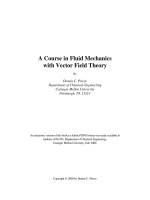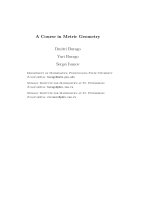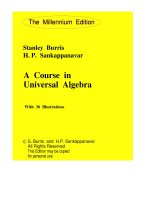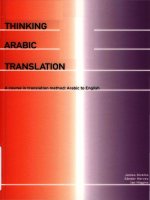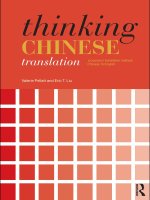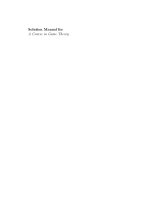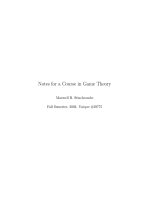thinking chinese translation a course in translation method chinese to english
Bạn đang xem bản rút gọn của tài liệu. Xem và tải ngay bản đầy đủ của tài liệu tại đây (2.41 MB, 235 trang )
Thinking Chinese Translation is a practical and comprehensive course for
advanced undergraduates and postgraduate students of Chinese.
Thinking Chinese Translation explores the ways in which memory, general
knowledge, and creativity (summed up as ‘schema’) contribute to the linguistic
ability necessary to create a good translation. The course develops the reader’s
ability to think deeply about the texts and to produce natural and accurate
translations from Chinese into English.
A wealth of relevant illustrative material is presented taking the reader
through a number of different genres and text types of increasing complexity
including:
Technical, scientifi c and legal texts
●
Journalistic and informative texts
●
Literary and dramatic texts.
●
Each chapter provides a discussion of the issues of a particular text type
based on up-to-date scholarship, followed by practical translation exercises.
The chapters can be read independently as research material, or in combination
with the exercises. The issues discussed range from the fi ne detail of the text,
such as punctuation, to the broader context of editing, packaging and pub-
lishing translations. Major aspects of teaching and learning translation, such
as collaboration, are also covered.
Thinking Chinese Translation is essential reading for advanced undergraduate
and postgraduate students of Chinese and translation studies. The book will
also appeal to a wide range of language students and tutors through the
general discussion of the principles and purpose of translation.
Valerie Pellatt and Eric T. Liu are both based at Newcastle University. Valerie
Pellatt is Lecturer in Chinese Translation and Interpreting and Eric T. Liu
is Senior Lecturer and Head of Translation and Interpreting Studies.
Thinking Chinese
Translation
Thinking Arabic Translation
A course in translation method: Arabic to English
James Dickins, Sándor Hervey and Ian Higgins
Thinking German Translation
A course in translation method: German to English
Sándor Hervey, Ian Higgins and Michael Loughridge
Thinking Italian Translation
A course in translation method Italian to English
Sándor Hervey, Ian Higgins Stella Cragie and Patrizia Gambarotta
Russian Translation
Theory and practice
Edna Andrews and Elena Maksimova
Routledge Encyclopedia of Translation Studies
Second edition
Mona Baker and Gabriela Saldanha
In Other Words
A coursebook on translation
Mona Baker
Becoming a Translator
An accelerated course
Douglas Robinson
The Scandals of Translation
Lawrence Venuti
Translation Studies
Susan Bassnett
Titles of related interest
Thinking Chinese
Translation
A course in translation method
Chinese to English
Valerie Pellatt and Eric T. Liu
First edition published 2010
by Routledge
2 Park Square, Milton Park, Abingdon, Oxon OX14 4RN
Simultaneously published in the USA and Canada
by Routledge
270 Madison Ave, New York, NY 10016
Routledge is an imprint of the Taylor & Francis Group, an informa
business
© 2010 Valerie Pellatt and Eric T. Liu
All rights reserved. No part of this book may be reprinted or
reproduced or utilised in any form or by any electronic, mechanical,
or other means, now known or hereafter invented, including
photocopying and recording, or in any information storage or
retrieval system, without permission in writing from the publishers.
British Library Cataloguing in Publication Data
A catalogue record for this book is available from the British Library
Library of Congress Cataloging in Publication Data
Thinking Chinese translation : a course in translation method:
Chinese to English / Valerie Pellatt and Eric T. Liu. – 1st ed.
p. cm.
Includes bibliographical references and index.
1. Chinese language–Translating into English. I. Liu, Eric.
II. Title.
PL1277.P45 2010
428′.02951–dc22
2009051695
ISBN 10: 0-
415-47417-5 (hbk)
ISBN 10: 0-415-47419-1 (pbk)
ISBN 10: 0-203-84931-0 (ebk)
ISBN 13: 978-0-415-47417-7 (hbk)
ISBN 13: 978-0-415-47419-1 (pbk)
ISBN 13: 978-0-203-84931-6 (ebk)
This edition published in the Taylor & Francis e-Library, 2010.
To purchase your own copy of this or any of Taylor & Francis or Routledge’s
collection of thousands of eBooks please go to ww
w.eBookstore.tandf.co.uk.
ISBN 0-203-84931-0 Master
e-book ISBN
Contents
Acknowledgements ix
Introduction 1
History, theory and practice of Chinese translation 1
The rationale and structure of Thinking Chinese Translation 8
1 Translation as a process 11
Formal schema: decoding the marks on the page 12
Content schema: knowledge and experience 15
Implication and inference 15
The benefi ts of collaborative thinking 17
Refl ective learning 19
2 Formal Schema – the framework: titles, sentences, punctuation
and paragraphs 21
Headings and titles: signposting the text 21
Sentences: grammatical structures 25
Sentences: discoursal structures 28
Punctuation: loaded with meaning 29
Paragraphs: fl eshing out the structure 33
Content schema: building knowledge, linguistic
enhancement, preparation and collaboration 35
Practical 2.1 Text structure and background knowledge 36
Practical 2.2 Background knowledge of China 37
3 Growing the schema from small beginnings 39
Translating formulaic texts 39
Content, context and register in the formulaic text 41
Practical 3.1 Certifi cates 41
vi Contents
Texts without sentences 44
Dictionaries and glossaries 45
Practical 3.2 Chinese restaurant menu 47
Practical 3.3 Translating accounts 49
4 Translating technical and scientifi c texts 52
Technical translation: what is it? Who does it? 52
Formal schema in technical and scientifi c translation 55
Content schema: understanding the processes 56
Practical 4 Technical exercises 59
5 Medical translation: persuading, reporting, and diagnosing
in the Western tradition 63
Public health information leafl ets 64
Practical 5.1 Persuading the public: health leafl ets 66
Translating medical reports 67
Practical 5.2 Patient’s notes 67
6 Translating traditional Chinese medicine 72
The underlying principles of traditional Chinese medicine 72
The language of traditional Chinese medicine 74
Practical 6.1 Treatment methods: cupping 74
Practical 6.2 Textbook description of cancers 76
7 Translating for legal purposes 78
Variations in legal systems and language 78
Authority of legal translation and the responsibility
of the translator 79
Legal texts as speech acts 80
Sentence structures 81
Verb forms 83
Terminology 83
Logical relations 85
Culture and ideology in legal translation 86
Domestic law translated for foreign visitors 88
International law: UN drafting 89
Practical 7.1 Analyzing bilingual laws 92
Practical 7.2 Translating domestic law on religion 94
Miscellaneous legal documents 95
Practical 7.3 Translator’s statement 95
Practical 7.4 Report of legal proceedings 96
Practical 7.5 Witness statement 96
Contents vii
8 Translating the business world: trust and obligation 98
The world of business 98
MOU, MOA and contract 99
Tenses 100
Idiomatic usage 101
Complex sentences 101
Distinguishing the Parties 102
Practical 8.1 Translating a Memorandum of Agreement:
proofreading and forensics 102
Practical 8.2 Translating a contract 104
9 Translating the nation 108
Addressing the nation 109
Translating ideology and power 110
China’s special brand of power 111
The narrative of China’s offi cial discourse 112
Commissioning the translation 113
Addressing the people: the group, the individual
and deixis in discourse 114
Choice of lexis 116
Metaphor and epithet 117
Numbers in Chinese offi cial discourse 120
China addressing the world 121
Formality and courtesy 121
Friends and brothers 121
Inclusiveness 122
All things positive 123
All things great 123
Practical 9.1 Addressing the nation 124
Practical 9.2 Addressing the world 124
Practical 9.3 Addressing a developing nation 125
10 Author-translator collaboration: a case study of reportage 126
Working together: interview with Xinran and Nicky Harman 127
11 Case studies: translating autobiographical writing 132
Paratextual analysis: re-adjusting the formal schema for
the foreign reader – Zhao Ziyang’s diaries 133
Practical 11.1 Transforming paratextual features for
the target audience 136
Translating the culture of the past: Zhang Xianliang’s memoirs 137
Practical 11.2 Translating culture across time and space 140
viii Contents
12 Translating fi ction 141
Narration 142
Translating Chengyu 143
Dialogue 145
Portraying character through dialogue 146
Expressing inner thoughts through dialogue 146
Relationship and interaction in dialogue 147
Insults 147
Description and depiction 148
Genre within genre 151
Practical 12.1 Translating description, emotion and refl ection 152
Practical 12.2 Translating the frustration of youth 152
13 Translation of traditional poetry 154
Formal schema in Chinese poetry 157
Content schema in Chinese poetry 158
Trade-off in language structure 159
Translating the past: allusion and culture-specifi c items 162
Punctuation and space in poems 164
Singular or plural, masculine or feminine? 164
The infl uence of Ezra Pound 165
Practical 13.1 Translating a three-syllable shi 166
Practical 13.2 Translating a yuefu 169
14 Translating twentieth century poetry 171
Translating Guo Moruo: the new poetry of the self 172
Western cultural allusion in Guo Moruo’s poetry 173
Personal pronouns and repetition 173
Practical 14.1 Discussion of Sky Dog source and target text 177
Translating the surrealism of Yang Lian 177
The Composer’s Tower 179
Practical 14.2 Discussion of The Composer’s Tower
source and target text 182
Postscript 183
Glossary 184
Appendix 186
References 211
Index 219
Acknowledgements
The authors and publishers would like to thank the following people and
institutions for permission to reproduce copyright material. Every effort has
been made to trace copyright holders, but in a few cases this has not been
possible. Any omissions brought to our attention will be remedied in future
editions. Bloodaxe Books for The Composer’s Tower by Yang Lian and trans-
lated by Brian Holton; John Cram for medical materials; Di Fer for extracts
from ᮐᰃˈϞᏱ⌒՚Փ (Whereupon, God Sent an Angel); Edwin Mellen
Press for Skydog by Guo Moruo, translated by Lin Ming-hui Chang;
University of Columbia Press for Nienhauser’s translation of The River has
Streams; Newcastle University for contract materials; Penguin for use of
material from Davis, A.R. (ed.) (1962) The Penguin Book of Chinese Verse, trans.
Kotewall, R. and Smith N.L.; Pul’ka for translations of Bai Juyi’s Waves
Scouring the Sand and The River Wanders; Michael Pushkin for valuable
advice on the poetry chapters; Renminwang and Xinhuanet for permission
to use news items; Global News Monthly for an excerpt from Lin Meng-Yi’s
article on Ё + ॄᑺ; Su Liqun for material from ⏋㸔Ѯᔧ; Xinran and
Nicky Harman for giving us their time and experience in an interview; all
the translators, writers and scholars whose wisdom and experience have
provided grist for our mill.
Introduction
History, theory and practice of Chinese translation
There have been waves of translation throughout Chinese history, sometimes
predominantly into Chinese, and occasionally predominantly out of Chinese
into other languages. The transfer of Buddhism over the Himalayas from AD 2
was dependent on translation, and the movement brought a new richness to
the Chinese language (Hung 2005: 57). The period of Jesuit mission in China
in the seventeenth century, at the beginning of the Qing dynasty, brought
another substantial impetus to the activity of translation, both into Chinese
from Latin, and out of Chinese (Spence 1990: 66, 132). A third major wave
was that of the late nineteenth and early twentieth centuries, when China
became acutely aware of the need for modern Western technology and science
(Spence 1990: 239). The adoption of Soviet-style writing for revolutionary
purposes during the fi rst half of the twentieth century might be regarded as
the fourth. Now, in the twenty-fi rst century, while on the one hand China is
integrating into global economy and culture, on the other hand the western
world has woken up to China, and has realised that the biggest nation on
earth does not necessarily write in English.
These notable episodes in translation history have certain aspects in
common. The fi rst two involved religion or philosophy. They were driven by
a deep spiritual need, or an urgent desire to proselytise. The third came at a
time when China was severely weakened by a corrupt, collapsing court,
threatened by European powers intent on ‘a slice of the melon’ and mired
in the poverty and ineffi ciency of unmodernised industry and economy. China
needed the ideas and technology of the nations that were systematically
plundering it. From the late nineteenth century a revolution in ideology,
language, industry and economy gained momentum, as intellectuals strove
for radical change in China. This was the period when Yan Fu introduced
the theory of evolution to China, while numerous radical writers like Hu Shi
and Lu Xun remoulded the Chinese language in such a way that it could
2 Introduction
carry modern ideas. During the fourth wave the translation of Soviet writings
was strictly ideological, symbolic of an alliance between socialist nations,
and a visible indicator of power: during the 1950s China was dependent on
the USSR for material and intellectual products. The current translation wave
sees China situated somewhat differently. The traffi c is much more a two-way
process, in that while China is still absorbing, adapting from and trading
ideas with the nations around the world, other nations now need to learn
from China in the same, immediate, instrumental way that China once looked
to them (Ma 1995: 273–387). The direction of the translation activity indicates
which side is in a position of power to provide knowledge and which side is
thirsty for it. If our metaphor for translation activity is waves, this book
focuses on the incoming tide, a rising tide of Chinese to English translation,
as evidenced in translations of Chinese traditional medicine, scientifi c research,
law, offi cial propaganda, business documents and literature. The new tide
indicates a perceptible change in global perceptions of Chinese language and
culture over the turn of the century.
The Thinking Translation series is well-known, and we feel that it is the
perfect site for our exploration of Chinese to English translation. One of the
founding authors of the series, Sandor Hervey, was a sinologist. In this book
we try to highlight the special characteristics of working from Chinese to English,
and in doing so fi nd it necessary to depart somewhat from the traditional
format and viewpoint of the previous books in the series. The book is aimed
at fi nal year students of Chinese or postgraduates, but may also be useful to
Chinese native speakers working into English, and for those working from
English to Chinese. The general approach we present in this book should be
applicable to either direction. We endeavour to present material and ideas
which are not simply a ‘how to’ manual, but an encouragement to think deeply
through the formal schema of both source and target text to the complex human
narratives involved. The Chapters may be read independently of the Practicals.
There are many books in Chinese on the issues involved in the translation
of English to Chinese, for this has been the main direction of travel for the
last hundred years or so. There are, however, fewer books and scholarly
papers on the subject of Chinese-English translation by scholars and translators
who are not native speakers of Chinese.
Chinese text books on translation are thorough, painstaking and in the
main accurate. But they tend towards the prescriptive, the detailed, and even
the pedantic. Some scholars feel that what has passed for theory in translation
scholarship in China has tended to be critical evaluation rather than the
formulation of theory (Chan 2004: 4). As Wang Hongzhi complains, there
may have been too much ‘ᑨ䆹ϡᑨ䆹’ (ought or ought not) (Wang 1999: 8).
Lin describes the translation of the mid- to late twentieth century as ‘too
rigid’, as translators were required by cultural affairs offi cials to adhere closely
to sentence structures and dictionary defi nitions (Lin 2002: 179). Much of
Introduction 3
this has to do with the prevalent Chinese political and educational environ-
ments over the past century, which inevitably refl ect the fact that China and
the English speaking nations are separated geographically and culturally.
Certainly in the early and middle parts of the twentieth century, China and
the English-speaking nations were worlds apart ideologically. English trans-
lations of Chinese texts from that period sometimes come across as rather
old-fashioned or quaint in style, or even pompous. This had in part to do
with the linguistic styles of Chinese propaganda current during the period
and in part to do with the isolation of China. The fi rst fi fty years of the
twentieth century saw China torn apart by civil war and foreign occupation,
during which only the hardiest foreigners would venture beyond the comfort of
Shanghai. The next thirty years saw China locked in a planned economy into
which few foreigners penetrated and from which few Chinese emerged. After
1949, translation was circumscribed, restricted to those foreign works which
were ideologically respectable, and to Chinese works which were politically
correct. The Chinese to English translations of the 1950s, 1960s and 1970s
may now seem awkward, over-formal and fl owery. These characteristics were
caused partly by the diffi culty of getting across the unique Maoist idiom of
the time. Succinctness, crispness and implicitness are virtues that belong both
to Chinese and English writing, and this is often forgotten by translators
anxious to render every word, perhaps for fear of criticism.
Along with a tendency to stilted, formal and fl owery English went a lack of
theoretical discussion of translation. Chinese textbooks on translation have
tended to be top-down prescriptive text books; this is changing, but even though
many Chinese scholars are now writing on real and relevant issues, they tend
to be too descriptive, ‘to the neglect of the cultural and contextual considerations
that have given rise to translation in China in the fi rst place’ (Lin 2002: 170). Our
intention in this book is to encourage consideration and discussion of lin-
guistic problems and wider cultural, psychological and ideological issues.
It was the case that until the end of the twentieth century relatively few
English-speaking people learned Chinese, while many Chinese learned English.
In terms of raw numbers, this will always be the case, but the proportion of
English-speaking learners of Chinese is growing fast. It is no longer the case
that translation and the instruction of translation must be done by a Chinese
native speaker, and it is now possible to speak in terms of what is a ‘norm’
in other language pairs. Translating from Chinese into English as the ‘mother
tongue’ or ‘A’ language, is desirable, preferable and possible, and becoming
much more widespread.
In the twenty-fi rst century, numbers of English speakers have the privilege
and the responsibility to translate Chinese into English that will ‘speak’ to
Anglophone and international audiences in the way that Ezra Pound and
Arthur Waley did before the establishment of the People’s Republic of China.
That responsibility entails thinking our way into the mind of the Chinese writer
4 Introduction
and their intended Chinese-speaking audience. Steiner calls this ‘penetration’
or ‘embodiment’ (Steiner 1975/1992: 319). Indeed there are many terms that
could be used. Inevitably, the brain is involved in translation, and we should
not forget that the brain is a physical entity. Whenever we indulge in any
kind of thinking, there are physical processes going on. Steiner has talked
about the ‘spatial organisation…of the polyglot’ (Steiner 1975/1992: 307) and
Jin develops this, albeit briefl y, in a comparison with simultaneous interpreting.
He talks about keeping the two streams of languages separated by their ‘alien
genius’. ‘Separation’ and ‘alien’ may not be entirely helpful concepts, but Jin
brings home the importance of ‘space’ and ‘genius’ in translation: that is,
the importance of becoming of, with and in the spirit of the source writer.
We should aim to produce the same message, with the same meaning, but it
may look and sound entirely different in form. For Jin the ‘space’ or the
‘separation’ provides opportunity for a process that is unencumbered by
interference from one or the other language (Jin 2003: 63).
In his discussion of ‘equivalence’ and correspondence, Ivir points out the
importance of the entire message, and the fact that when we translate we are
not indulging in a linguistic comparison for its own sake, but producing a text
(Ivir 1995: 291). Some scholars of translation have gone so far as to reject the
role of language altogether (Holz-Mänttäri 1986), but that is somewhat extreme.
The text is the clothing of the meaning, the gateway to the meaning. A trans-
lator cannot avoid using it, and has a responsibility to respect it. Nevertheless,
we should avoid being enslaved by the text, or prostituting our ideology to
the stake-holders, whether that is the source writer or the target client.
In moving the emphasis of this book away from that of others in the
Thinking Translation series, we hope to bring to Chinese translation the
fl exibility, creativity, appropriateness and readability that have sometimes
been eroded by ideological correctness and commercial urgency. That is not
in any way to criticise the well-known, talented translators of the nineteenth and
twentieth century – without them our knowledge of Chinese literature and
culture would have been scant indeed. A lot of good sense has been disseminated
by Chinese translatologists over the years. Our hope is to instil in new English-
speaking translators the ability to think their way in and out of the Chinese
and English boxes with agility. There is still something of the magical about
translation. Although for the translator it is just an extension of everyday
linguistic activity, the people for whom it is done do not always quite under-
stand how it is done. Like a prestidigitator or a pyrotechnician, the translator
creates something whole, structured, seamless and of perfect impact.
The key notion underlying this book is the schema: our application of
knowledge and experience to our understanding of text (see Chapter 1 for
a more detailed explanation). Schema is a notion which may now sound
outdated, but it is useful in that it encompasses the entirety of cognitive
activity, and can deal comprehensively with the translator’s complex task of
Introduction 5
reading, thinking and writing. Schemata operate top-down and bottom-up
(Romero and Kemp 2007: 322). From the translator’s point of view, top-down
entails the wider world, the source and target cultures, the whole text; bottom-up
entails the words on the page, the punctuation, the grammar. The words on
the page trigger the schemata associated with the wider world and the general
knowledge which feeds our specifi c and linguistic knowledge.
Schemata are with us in everyday life, always, everywhere. Reading the
headline ‘Sturgeon reveals personal experience of superbug’ (The Scotsman
Friday June 20th 2008: 3), for a fraction of a second, we might imagine big
fi sh and their live-in parasites. But then we remember that ‘Sturgeon’ is the
surname of a politician, and ‘superbug’ is MRSA, (methicillin-resistant
Staphylococcus aureus superbug infection) a disease endemic in many
hospitals. For a moment, we have fallen prey to a dominant schema – perhaps
we prefer wildlife to political life – and the words on the page have triggered
a misunderstanding. This can be rectifi ed by reading further into the text,
and such misunderstandings are usually easily cleared up. Hervey and Higgins,
in Thinking French Translation, mention the common student confusion of the
French words cuir and cuivre. It is a very simple ‘bottom-up’ reading error, but
it triggers a schema. If, through careless reading, we translate ‘de vieux samovars
de cuivre’ as ‘old leather samovars’ (Hervey and Higgins, 1992/2004: 176), at some
point general knowledge, that is a part of our schema, should kick in and
warn us that boiling water is not usually associated with leather. Our schema
needs to be suffi ciently developed to include Russian tea making. Zakia Deeb,
in her investigation of student translators’ errors, shows how misreading of
vocabulary items, which we might otherwise call ‘bottom-up decoding’, can
produce dangerously incorrect schemata. She cites the example of ‘surrogacy’
being read as ‘surgery’ and describes how the student’s Arabic target text
was restructured to allow the error to make sense (Deeb Forth coming: 24).
This is a phenomenon with which all teachers of translation, and probably
quite a few students of translation, are familiar. But schema operates in a
wider way. It implies being in and with the writer and the reader. We must
understand both, ducking and diving, boxing and coxing, in such a way that
the rabbit becomes a dove and the sawn-in-half lady becomes whole again.
Fortunately for the modern English-speaking linguist, with around a million
words to deploy (Payack 2008), that wider world is more or less infi nitely
expressible. Between and in languages exist correspondences of one to many
and many to one. Language connives and collides kaleidoscopically across
time and space. Given the richness of every language, there should be no
‘can’t’ for the translator: as long as the source text is fully understood there
will be a solution to the momentary problem. In a worst-case scenario we
can explain within the text, or footnote, but whatever we do, deep under-
standing is the key. Let us take just one example from twenty-fi rst century
fi nance: the phrase ‘sub-prime mortgage’ fi rst crept into common use in the
6 Introduction
Anglophone world around 2007. It is a very neat expression used by wheeler-
dealers to sum up a situation in which unfortunate borrowers who have been
refused credit by respectable companies have taken on mortgages which they
cannot afford. In 2008, there was still no single Hungarian word which could
cover this. The translator or interpreter had to use a whole sentence to convey
the meaning in Hungarian (Claudia Zimmermann, personal communication,
30.6.08 at the European Parliament). But this will change, for as the concept
becomes common in each geographical area of the globalised culture, a neat
one- or two-word phrase will be coined. One Chinese version is 㑻᠓䌋,
(secondary or ‘sub’ house loan). It is always diffi cult to know exactly how or
when a new word or phrase comes into use, and sometimes even more diffi cult
to provide a translation. Cases of ‘new’ Chinese words are legion: ‘ᇣᒋ⼒Ӯ’
(small, healthy society), for example, burst upon the scene in mainland China
in about 2002, having been used in Taiwan for some time, but now bearing a
new, ideologically portentous meaning. Like many Chinese abbreviations it
carries a weight of implication, and moreover, at the time it was a rather novel
idea that ordinary Chinese people could build up monetary and material
wealth, and that the Chinese government would encourage them. Translators
and interpreters seemed to settle on the term ‘well-off society’. As Chinese
life and customs change, new concepts and new words are emerging daily.
Who invents the new words, and who coins their offi cial or conventional
translations? It is probably the translator. The translator must shift with the
language, fi rst understanding deeply then exercising at one moment great
and necessary caution, or at any given moment, innovative courage.
Individual words do matter, as they make up the ‘texture’ of a text, in fact
a single word may be a text. Hervey and Higgins (1992/2002: 6) note that a
text may comprise a single word and many scholars would use the term ‘unit
of translation’. We prefer to use the term ‘text’ as we believe that ‘units of
translation’ are probably as varied in nature and size as ‘ideas’. Every translator
approaches the text in different ways all the time, sometimes using small bits,
sometimes big bits. Nowadays, most translators and researchers would regard
the whole text – however big or small, as the ‘unit of translation’. For the
expert, translation may be automatized, in the case of very common phrases
and words. It may be cumulative, as successive pieces of text trigger greater
understanding, and translators, or their software, hold in their working
memory the necessary solutions, modifying them as the text progresses. Jin
talks about making comparisons and adjustments (Jin 2003: 103). These
modifi cations are linguistic manifestations of the translator’s evolving schema
as the reading and understanding of the text progresses.
Schema and imagination are not exclusively applicable to literary texts.
The accountant, the builder, and the vet all need a translator who can think
beyond the words. A vet, for example, needs a translator who knows that a
Introduction 7
grandmother chicken is not a loveable storybook character, but a technical
term. Sometimes it is the blindingly obvious solution that is needed, some-
times not, and it is up to translators to develop schemata that will help them
to the right solution. One important aspect of translator training (whether
this is class-room training or self-training) is the ability to think outside the
text and to think ‘with both sides of the brain’. As a wordsmith, the translator
may be expected to be using those areas of the brain associated with language
and serial processing. In addition, and perhaps contrary to expectation, the
translator must use areas of the brain which deal with spatial mechanical
processing. In talking about ‘spatial organisation’, Steiner (see above) is
concerned with the multi-lingual layers of the linguist. We cannot ignore the
‘spatial organisation’ which involves cognition beyond the linguistic sphere.
The development of spatial-mechanical thinking is essential for the linguist.
The good translator is the one who can switch on an ‘internal video’ and
‘internal radio’. It helps to be able to summon up cerebral sensations of
aromas and fl avours. Telling a British or American readership how a Chinese
machine works, the patent translator must have a haptic knowledge of move-
ments like stirring, grinding, and spinning. A Chinese pain that feels ‘sour’
is probably felt by a British patient as a ‘dull ache’. The translator must feel
that sour pain as a Chinese patient feels it, and turn it empathetically into
a dull English ache.
Students of translation need to be able to build good schemata. They need
to know how to read the source text so as to give them the right schema, and
they need to approach the text in such a way as to develop their understanding,
not only of the words, but of the thought patterns, and the mechanical or
physical processes described in the text.
Schema building is not an individual, isolated process: it can and should
involve colleagues and informants. Decades ago, when pupils translated
French and Latin texts at school, collaboration with fellow pupils was strictly
prohibited, and use of dictionaries was forbidden in examinations and tests.
Now, however, educational institutions are increasingly aware that collaboration
and research are purposeful, fruitful methods of learning, and students can
be encouraged to use dictionaries and the internet intelligently, and to use
informants. Knowing who or where to consult, knowing how to explain the
problem, converting the answer into a reader-friendly solution and storing
the knowledge gained ready to use at a later date, are all component skills of
schema building. One of the best ways to do translation is to do it in pairs,
or as a team. Native speakers of each language contribute their respective
knowledge, jointly establishing a schema for the work in hand. Collaborative
working is the norm for professional translators employed by international
organisations and agencies, and we do well to incorporate the collaborative
principle into training at whatever level.
8 Introduction
The rationale and structure of Thinking Chinese Translation
While it is evident that we have used the term ‘schema’ a little differently
from that of the earlier Thinking Translation books, in which it was used to
formalise the characteristics of different text types in matrix style, we have
not abandoned text types. Genres or text types are an indispensable feature
of translation, and will be discussed in relation to the notion of formal
schema. The rationale of the book is not entirely different from the previous
Thinking Translation books, in that schema building includes the all-important
factors of the purpose, or aim of the translation, and the type of text. Jin
notes that ‘it is simply impossible not to have any aim’ (Jin 2003: 102). The
aim may be to get the work done by 4 am this morning in Shanghai, so that
it reaches the client at 8 pm yesterday in London; it may be to create the
most fl uent, evocative version of a poem possible, regardless of time con-
straints; it may be to ensure that foreign visitors know how to avoid, or deal
with, local endemic health risks. Our aim should be to make something
happen at the point where the client encounters the translation. Let us add
to the confusion by using our private term for the what-who-why-where-how
of translation: destiny. The translation of a text is destined for certain readers
in certain places, doing certain things. It has a destination and a destiny. It
may be destined for an overworked divorce lawyer, or, if it is a translation
of great canonical literature such as Ba Jin’s ᆊ (Family) it may be destined
for immortality. Bearing in mind that translations have changed the world,
student translators have to think behind and within the text as they work
with it, then beyond the text to its role and destination.
It is a sad fact that people are still complaining that new translators have
spent too much time studying literary and historical texts. Novice translators
are not always conversant with the world of commerce and politics into
which they suddenly fi nd themselves thrown. Translator trainers everywhere
are trying to rectify this, but there is still a need for programmes and materials
which introduce the trainee translator to the real world of work (Prieto and
Linares 2010). The texts used in this book are in almost all cases based on
or excerpted from authentic texts, in that they are derived from texts that
have been translated as professional assignments at some time, by some
translator. Some have been especially adapted for the book, but follow the
form of generic documents. Some have also been used as teaching material.
Authentic texts are not necessarily perfect texts, and translators are sometimes
expected to deal with imperfect grammar, misprints and malapropisms. This
includes even ‘deliberate mistakes’, deployed for stylistic reasons, as discussed
by Jin in his exploration of the translation of Ulysses (Jin 2003: 45).
There is a slight complicating factor in that modern Chinese texts produced
for business purposes, such as contracts, patents or specifi cations, were, in
the early years of China’s liberalisation, sometimes adapted from English texts.
Introduction 9
Occasionally a translator is faced with a slightly awkward text which is likely
to have been based on a model adapted from English. Even when texts draw
heavily on models in the target language, it does not mean that they are inauthentic
texts. For example, a Chinese version of a British or American company brochure
written for a branch in China will become a localised, specifi c product of joint
enterprise, and needs to be approached as such by the translator.
The texts selected or adapted for the ‘Practicals’ came from Greater China,
including Hong Kong and Taiwan. They are delivered in either simplifi ed or
traditional characters, according to the original publication, and we assume
that our readers will be well acquainted with both systems. Illustrative examples
occurring in the body of the text other than the ‘Practical’ texts, and items
such as grammatical terms are in simplifi ed characters. Where it is necessary
to use transliteration, pinyin is used in the body of the text, except where a
quoted writer uses other transliteration methods, such as Wade-Giles.
Not all the ‘Practical’ exercises are straightforward translation tasks. As
part of the schema building agenda we have included questions and tasks
which we hope will encourage broader and deeper thinking. In the appendix
we have provided suggested or alternative solutions to the ‘Practicals’, but
these are not presented as model answers or ideal solutions. We leave it to
our readers to discuss them and criticise them.
The fourteen chapters of this book are not necessarily of equal length:
they refl ect the fact that texts and translations are far from uniform, and size
may not always correlate with importance. We expect that teachers and
students who use the book will mix and match. For example, some may
prefer to include birth and marriage certifi cates in a workshop on legal
translation, while contracts could be included in a session on commercial
translation. We are not expecting our readers to follow the chapters slavishly,
and we hope that individual learners and teachers will ‘dip in’ to the book
and use the ideas with their own preferred material.
The texts examined in the book not only increase in size from single word
components to excerpts from novels, but also progress ‘along life’s way’,
refl ecting our aim of schema development. Chapter 1 deals with the way the
notion of schema works in relation to translation. Chapter 2 explores in
some detail the linguistic challenges of the text on the page, together with
layout (formal schema), and the psychological and social processes and
practices of translation (content schema). Chapter 3 deals with texts which
consist only of words or phrases and not of sentences. We ‘grow’ the schema
from bottom-up decoding. Some of the texts in this chapter are the ‘rites of
passage’, that is, texts which are the mainstay of many a beginner translator’s
work, and are linked to the future and fate of the client. These are the birth,
residence, marriage and academic certifi cates that enable the crossing of
physical and professional borders. The second part of this chapter deals with
the special genre of lists. These are texts which consist mainly of nouns, but
10 Introduction
are in constant daily use and need just as much thought and attention to
detail as those which have highly complex grammar. Chapter 4 moves on to
text in which terminology is perceived as dominant, the dense, descriptive
writing of science and technology. Chapter 5 deals with health and well-being.
Western-style medical texts are factual and simple in their formats and
grammatical structures. The records of professionals may require very
specialist vocabulary, in which accuracy is important, perhaps even a matter
of life and death. Chapter 6 explores the concepts and language of Traditional
Chinese Medicine. The organs of the body are relatively uniform around
the world, but the way in which each culture talks about them is distinct.
Linguistically and culturally, Traditional Chinese Medicine occupies a different
‘universe’ from that of ‘Western’ medicine. Chapter 7 deals with translating for
legal purposes. The language of the law is special in its performative function.
It refl ects the workings of society. It is a fi eld in which texts may be very complex,
and have at the same time a high degree of conventionality and extremes of
vagueness and precision. Legal translation work requires sensitive interaction
between professionals and the public. Chapter 8 extends the discussion of
performative texts to the contracts and memoranda of the business world, which
echo the legal world in their emphasis on trust, obligation and conventional
behaviour. In Chapter 9 we look at the way a nation presents its image in
translation through its ideological stance and power relationships. This is
counter-balanced in Chapter 10 by the view of a Chinese writer from outside
China. As a contrast to previous chapters which focus on the task of translation,
this chapter combines the insights of the journalist and her translator with their
views on collaborative work. Chapter 11 moves further into the realm of literary
writing and translating through the form of memoir and autobiographical
writing. In the fi rst part of the chapter we use a translated memoir to illustrate
the translation of paratextual features. The second part of the chapter focuses
on the textual considerations of writing about the past. This discussion of
autobiographical writing paves the way for the translation of fi ction, discussed
in Chapter 12, in which we approach the component text types of literary writing:
narrative, dialogue and refl ection. The book culminates in two chapters on
poetry translation. A discussion of twentieth-century translation of ancient poems
in Chapter 13 leads us to the pleasures and problems of translating modern
poetry. We noted earlier in this introduction that trainers and trainees are often
aiming at expertise outside the literary sphere. We have included poetic and
literary translation for two main reasons. First, while most professional trans-
lation work is non-literary, literary translation from Chinese to English is a
growing fi eld. Second, literature is of enormous importance and value culturally
and economically and is enjoyable. The conundrums of poetry translation
provide a rich training ground.
1 Translation as a process
The process of translation may start even earlier than the reading of the text,
in the building of general knowledge, language skills and lateral thinking.
The fi rst stage of any theoretical or pedagogical discussion is to look at what
we read and what prior knowledge we bring to reading. The notion of schema,
fi rst coined and developed by Bartlett (1932), is based on memory, ‘literally
reduplicative and reproductive’, which ‘every time we make it has its own
characteristics’ (Bartlett 1932: 204). All the formal and informal learning we
have done, factual, abstract and emotional, every memory, good or bad,
vague or detailed, including the physical sensations that go with human
activity, combine to bring understanding to our reading.
As we observed in the introduction, translation at some levels may become
automatised, particularly in the older, experienced translator, and especially
in the case of specialisation in a restricted fi eld. While expert knowledge
helps us to produce the right answer quickly and smoothly, there may still
be a great deal of working out, associating, manipulating and checking to
be done. Most texts will require the reading of new material, necessitating a
degree of word- and sentence-level decoding.
The notion of schema has been used in theoretical and experimental work
on reading processes, enabling researchers like Rumelhardt (1977) to build
models of ways in which effective reading is done. Since reading is a major
part of translating, we may apply the schema model to translation.
Reading begins, and only begins, with the decoding of the words on the
page. It is a complex information processing activity, and is not necessarily
linear in nature. We work backwards and forwards in the text working out the
meaning, confi rming and correcting our apperception. While the ‘lower stage’
(print on the page) triggers meaning, the information supplied top-down
from the reader’s general knowledge and memory will infl uence the way we
construe the words on the page. We use syntactic, semantic, lexical and ortho-
graphic clues to spark the messages and narratives the author is transmitting
(Samuels and Kamil 1988: 27–29). Reading a text is an interactive, constantly
12 Translation as a process
evolving creation and manipulation of meaning. If this is what happens in
monolingual reading, the effect is likely to be similar, but perhaps more com-
plex, for the reader-translator, whose schema will be bi-cultural and bilingual.
The syntactic, semantic, lexical and orthographic clues, together with layout
and structure of the text provide a ‘formal schema’. This is the physical print
framework in which the reader creates a ‘content schema’. The content schema
is an understanding of the informational and implicational content of the
text. The translator applies the content schema to re-create the text within
the framework of a new formal schema in the target language.
Formal schema: decoding the marks on the page
Jin points out that ‘the spirit and form of a text are inextricably united’ and
‘the translator needs to grasp the message by absorbing the whole body of
the source text, including all the features of its language, down to its minutest
particles . . .’ (Jin 2003: 53). This is the formal schema, and the ‘minutest
particles’ give us crucial information about the text.
Every text, however incoherently written, or illogically constructed, has
some kind of form. The shape, size, texture and components of the text give
the fi rst clues to its meaning and message. The title will tell us what the text
is ‘about’. That is perhaps an optimistic statement. In the case of literature,
and even newspaper and magazine articles, authors may sometimes use a
very subtle or humorous title or heading. The reader may only become aware
of the meaning of the title by reading the whole work. Frequently an elegant,
succinct title is followed by a colon and a phrase or two that tells you a little
bit more. The colon has a meaning: it means ‘what I am actually going to
write about is . . .’ Even in situations where the title is not entirely transparent,
it is a contribution to the meaning, a clue to the writer’s attitude or character,
and helps to build understanding of the work.
Perhaps the ‘minutest’ part of a text is the punctuation. Every language
uses punctuation differently, to signal different things, and this is part of the
formal schema. The following is a sentence from a test transcript, followed
by two actual renderings:
Example 1
៥Ёⱘᯊ㹿ϔ㕸⌕⇧⫼ạᄤᠧǃ⫼ߔᄤ᠇DŽ
1a. When I was in China I was beaten up by a gang. They hit me with
sticks and stabbed me with knives.
1b. When I was in China I was beaten up by a gang. They hit me with
sticks and I stabbed them.
(Wu, F. 2008)
Translation as a process 13
In the Chinese sentence there is no overt direct object of the hitting and
stabbing: it is a typical example of a Chinese zero pronoun. The comma
between the hitting and the stabbing is of the type which is used in lists, so
the reader can fairly safely assume that hitting and stabbing constitute a list
of things the hooligans did, as in Example 1a. However, if the comma is
ignored, or misread as the kind of comma that links phrases or clauses, the
reader might call on schema to interpret the second zero object as the gang,
as in Example 1b. So the two readings of the same sentence result in a victim
schema on the one hand, and a retaliatory schema on the other. This example
shows how it is inevitable (and important) that bottom-up reading of the
‘minutest’ parts of the text interacts with the common sense and logic of
top-down schema.
Colons, semi-colons, dashes and commas all link parts of sentences in a
meaningful way. A comma in Chinese may indicate ‘new idea coming next’,
and we might want to use, instead, a full stop in an English translation (a
more detailed account of Chinese and English punctuation is given in Chapter
2). Much has been written about Chinese paratactical sentences and English
hypotactical sentences, variously evoked as ‘towering trees’, ‘bamboo sticks’
and ‘bunches of grapes’ (Tan 1995: 482), ‘building blocks’ and ‘chains’ (Liu
1990). The translator can learn a great deal from a linguist’s analysis. It is
not simply the case that long English sentences need to be broken up into
short Chinese sentences or vice versa. Punctuation, including the different
kinds of comma, needs to be mined for its meaning, so that the text and
its component sentences can be appropriately restructured. It should be
emphasised that not every sentence needs to be restructured. Thoughts which
have followed the same pathways and networks in the Chinese-speaking
and English-speaking brain may need to follow the same syntactic pathway
on the page.
Perhaps it is patronising to point out to highly literate translators that
paragraphs are also part of the structure of a text. We need to think about
the respective role that paragraphs play in Chinese and English text and the
differing roles that paragraphs play in various genres. Internet writing often
uses many very short paragraphs, so do we, as translators, stay with the
brevity, or concoct a new lengthiness? Do we shift a paragraph, or a sentence
that sits well in Chinese, but sounds out of place in English? What is the
writer’s intention in division of the text into paragraphs? What do those
line-spaces signal? And what about the texts that have no paragraphs as such,
but consist of lists, and boxes and thought bubbles? Are Chinese boxes and
bubbles the same as English boxes and bubbles?
Spacing in a printed text can signal more than just the beginning and
end of paragraphs or sentences. Advertising, poetry and title pages are just
a few of the types of text which use both line and word spaces for visual
effect. It may be that the translator can simply transpose the pattern of
14 Translation as a process
spaces. On the other hand, it may be necessary to modify the space patterns
to make sense in the target language. This will be discussed in more detail
in Chapter 12.
The formal schema of a text also tells us about time and space, events,
processes, activities and physical and mental conditions. To convey these
messages, the authors use all the linguistic building blocks at their disposal:
nouns, pronouns, time adverbs and tense, weights and measures, verbs, adverbs
and adjectives. In addition, the way these blocks are arranged and combined
in patterns of coherence is a crucial part of text structure. Chinese reference
chains, consisting of nouns and pronouns, for example, do not always work
in quite the same way as English reference chains. A Chinese writer may
foreground or highlight a protagonist or subject by not mentioning him/her/it,
whereas he may background, or demote a person or object by the use of full
noun phrases (Pellatt 2002: 173).
Finally, there is the fact of the words on the page. For example, there is
the problem of what to do with the word, or thing, or idea that seems to
belong exclusively to the source language, and for which it is at least diffi cult, if
not impossible, to fi nd an effective, neat word or phrase in the target language.
Often it is easy to understand and fi nd an appropriate way of conveying
these in the target language, for not only are the notions of time, space etc.,
common to all human beings, but so are physical and mental sensations
and behaviour. However, while we may experience the same sensations and
experiences through our similar human physicality, we may express them
rather differently. Our common human knowledge helps us to express our
individual and culture-specifi c concepts.
This is where the formal schema of the text is important. In the case of
individual words and expressions it is necessary to plumb the context for
meaning: the formal schema gives you a whole raft of information, ideas
and sensations which will help to lead you to a good solution.
The notion of the formal schema can be extended to the question of style
and register, and even to what Jin calls ‘overtone’ (Jin 2003: 118) and which
might also be described as ‘between the lines’ or ‘implicit’ or ‘underlying’. If
we take, for example, one of the simplest, shortest texts, a certifi cate of birth, or
marriage, or of graduation, we are faced with a text that has status and impact
in law. There are not many words, and there is not much ‘reading between
the lines’ to be done, but the formal schema of the source text, its layout
and presentation, requires a suitably formal and solemn translation. For some
inexperienced translators that may conjure the idea of long words and complex
sentences, whereas what is really required is concision and precision.
There are, needless to say, conventions, and an important part of the
translator’s education is to develop knowledge of conventions. Some scholars,
for example, Kaplan (1966) and Connor (1984), have claimed that texts in
